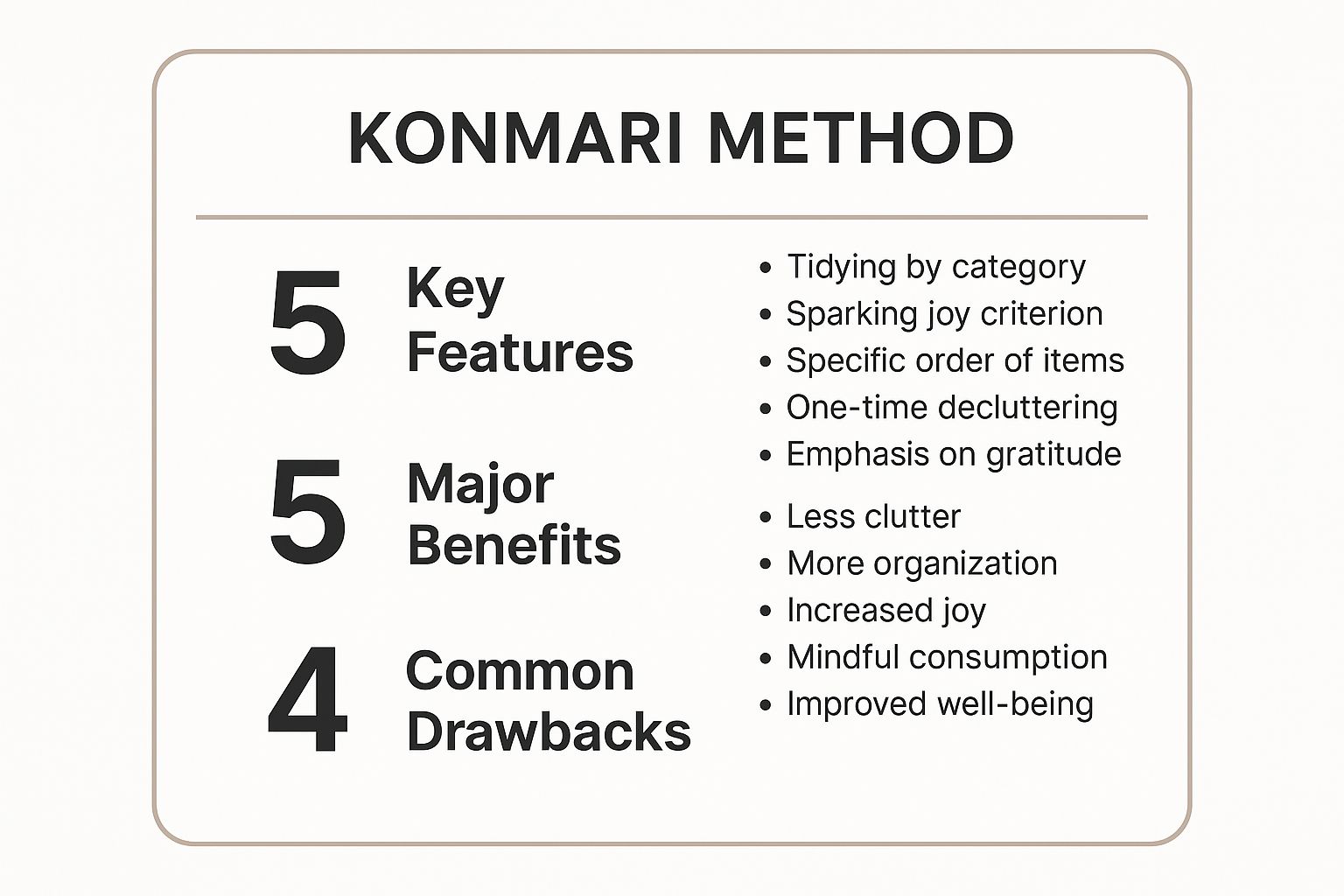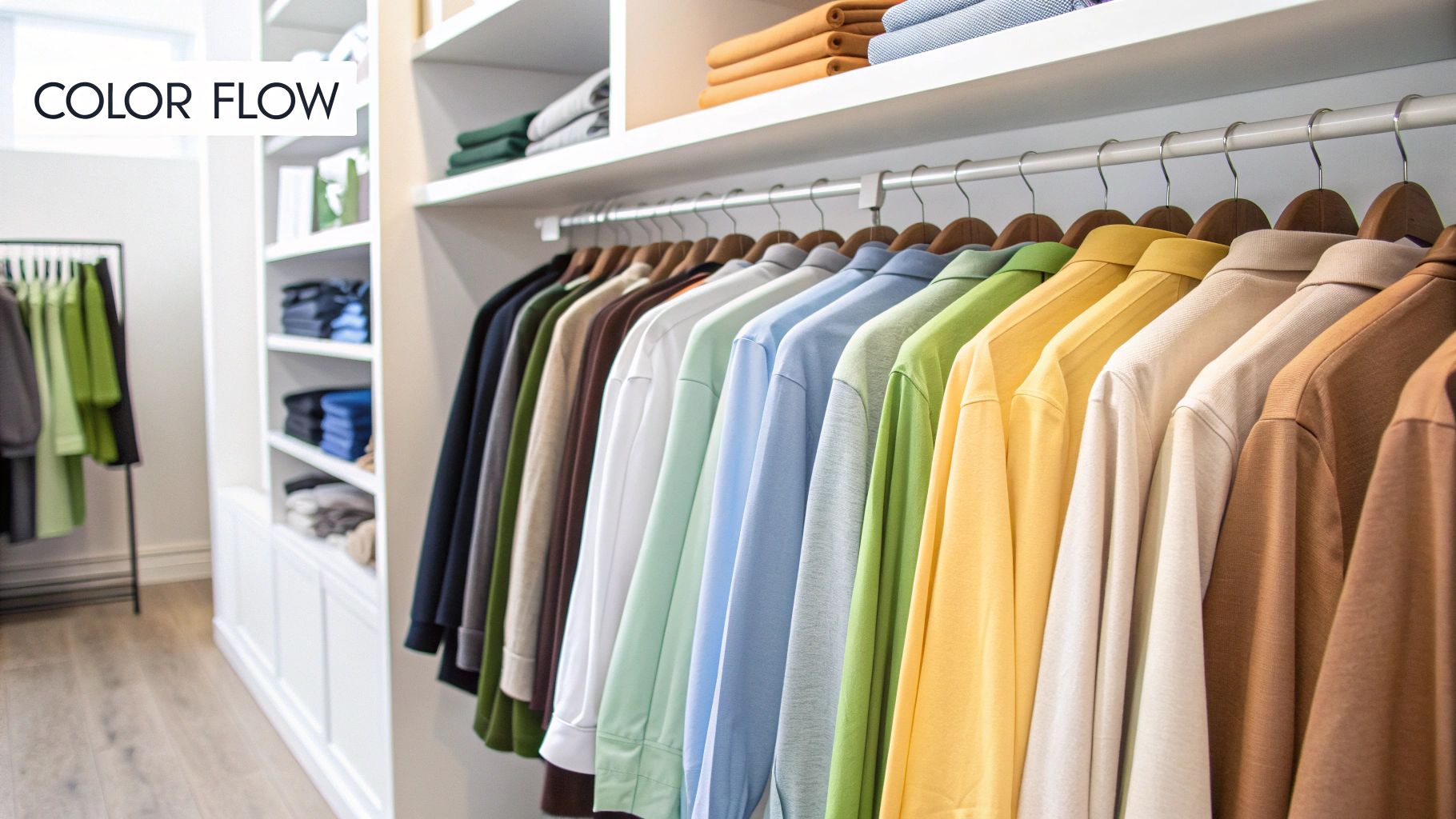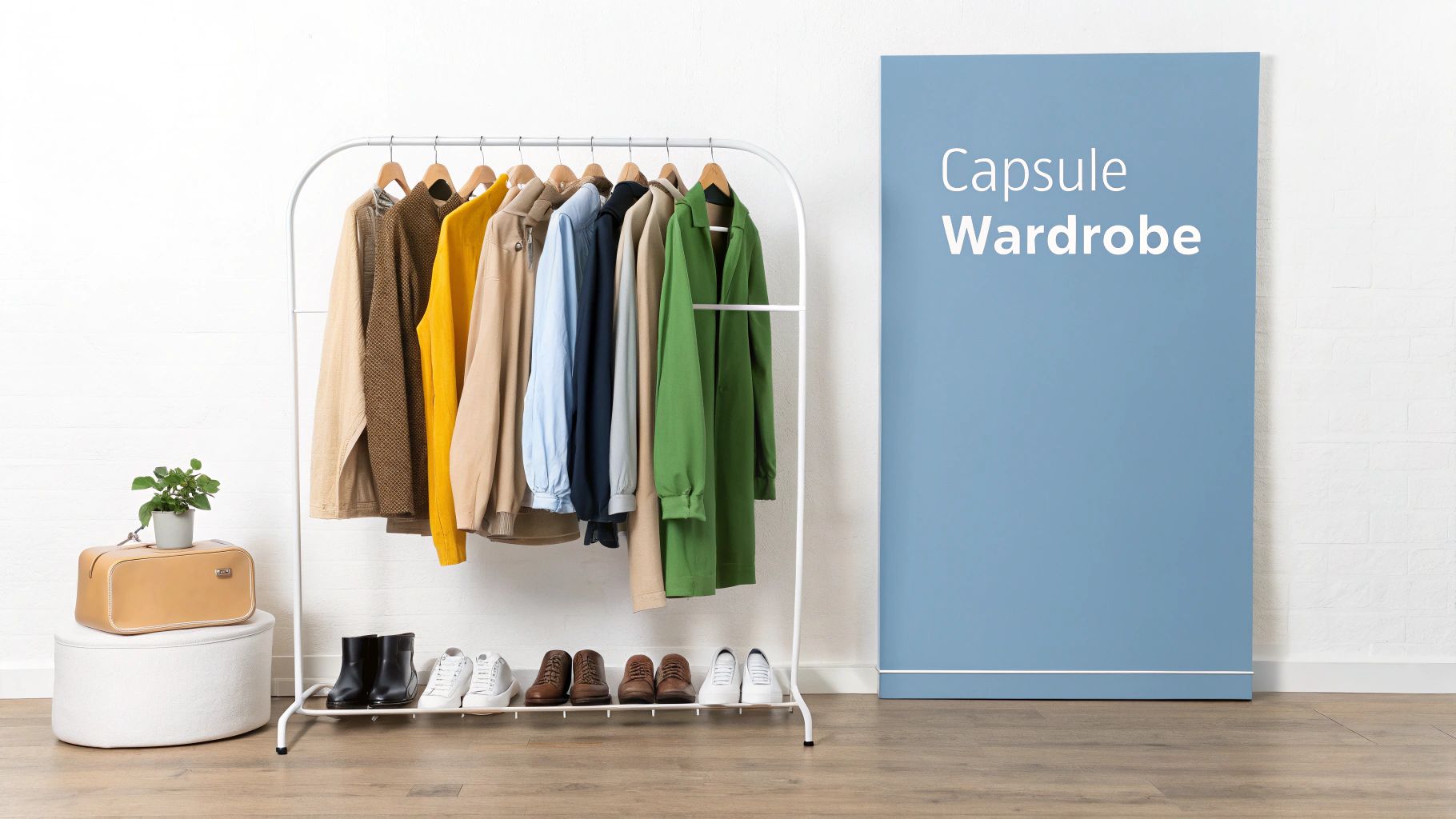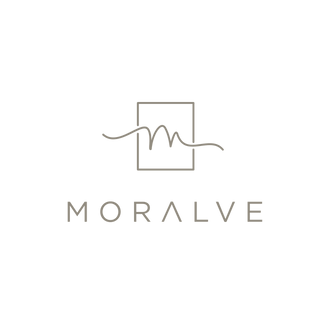7 Reach In Closet Organization Ideas for 2025

Struggling with a small, cluttered reach-in closet? You're not alone. These compact spaces often become a chaotic jumble of clothes, shoes, and accessories, making it nearly impossible to find what you need when you need it. A well-organized closet, however, is completely within reach, and achieving it can significantly reduce morning stress and streamline your daily routine.
This guide offers a collection of practical and innovative reach in closet organization ideas designed to maximize every square inch. We move beyond generic advice to provide seven distinct, actionable methods for conquering clutter and creating a functional system that works for you. From the minimalist KonMari approach to strategic seasonal rotations and efficient double-hang systems, you will discover a variety of techniques to transform your wardrobe.
Whether you're a fashion enthusiast with an ever-growing collection or an apartment dweller trying to make the most of limited space, there's a solution here to help you build a closet that’s not just organized, but a genuine joy to use. This list will equip you with the specific insights needed to implement these systems effectively. Let's dive in and unlock your closet's true potential.
1. The KonMari Method for Closet Organization
The KonMari Method, developed by Japanese organizing consultant Marie Kondo, is more than just a tidying technique; it's a philosophy centered on keeping only items that "spark joy." This approach is an excellent starting point for any closet organization project because it forces you to confront your belongings on an emotional level, ensuring that your reach-in closet becomes a space filled only with clothes you truly love and want to wear.
The process begins with a single, transformative step: removing every single item from your closet and piling it all in one spot, typically on your bed. You then pick up each piece of clothing individually and ask yourself, "Does this spark joy?" If the answer is a resounding yes, you keep it. If not, you thank the item for its service and let it go. This initial purge is the foundation for creating a harmonious and functional space. For a deeper dive into this first crucial step, explore our guide on how to declutter your closet.
Key Principles of a KonMari Closet
Once you've curated your joy-sparking wardrobe, the organization begins. Unlike traditional methods that might group items by season or occasion, KonMari focuses on categorization.
- Organize by Category, Not Location: All shirts go together, all pants in another section, and so on. This prevents you from having forgotten items scattered in different parts of your home.
- Vertical Folding: For items in drawers or bins, Kondo's signature vertical folding technique is a game-changer. It allows you to see every item at a glance, prevents wrinkles, and maximizes drawer space.
- Aesthetic Harmony: The method encourages using uniform, high-quality hangers for all hanging clothes. This creates a clean, visually calming line that reduces visual clutter and makes your closet feel more like a curated boutique.
This infographic provides a quick reference to the features, benefits, and potential drawbacks of the KonMari method.

The visualization highlights how the method’s focus on decluttering and mindfulness leads to a more organized and intentional wardrobe, though the initial time commitment can be a hurdle for some.
How to Implement KonMari Folding
Mastering the vertical fold is essential for the KonMari method. While it may seem complex initially, it's a simple skill that transforms how you store your clothes. The video below offers a clear, step-by-step tutorial.
2. Double-Hang Rod System
One of the most effective reach in closet organization ideas is to maximize vertical space, and the double-hang rod system is a classic, high-impact solution for achieving this. This simple yet brilliant concept involves installing a second hanging rod below the primary one, instantly doubling your hanging capacity without expanding the closet's footprint. It’s an ideal strategy for closets that are tall but not necessarily wide, making it perfect for storing shorter items like shirts, blouses, skirts, and folded pants.
This method transforms underutilized vertical real estate into prime storage. Instead of having a single rod with lots of empty space below your shirts, a double-hang system creates two distinct, functional levels. This not only increases storage but also improves visibility and accessibility, as items are less crammed and more neatly segmented.
Key Principles of a Double-Hang System
Implementing a double-hang rod system requires a bit of planning to ensure it functions smoothly. The goal is to create two usable tiers without making either one feel cramped or inaccessible.
- Measure for Clearance: Before installing, measure your longest short-hanging item (like a blazer or tunic). Ensure there’s enough vertical space for it on both the top and bottom rods, typically leaving 3-4 inches of clearance at the bottom of each tier.
- Prioritize Accessibility: Place your most frequently worn items, such as daily work shirts or favorite blouses, on the lower, more accessible rod. The upper rod can be used for less-used items or off-season clothing.
- Strategic Placement: Don't feel obligated to double-hang the entire closet. A popular configuration is to dedicate one section to double-hanging for shirts and pants, while leaving another section as single-hang for longer items like dresses and coats.
This system is particularly effective for organizing trousers. By folding pants over a hanger, they fit perfectly on a double-hang rod. You can explore various techniques in our guide on how to organize pants in your closet.
How to Install a Double-Hang Rod
Adding a second rod can be a simple DIY project. You can use an adjustable, tension-mounted rod for a no-drill solution or opt for a more permanent, screw-in system for greater stability and weight capacity.
- Determine Heights: A standard top rod is often placed around 80-82 inches from the floor. A second rod is typically installed around 40-42 inches from the floor, leaving you with roughly 40 inches of hanging space on each level.
- Mark Your Placement: Use a level to mark the exact spots where the brackets for the new rod will go.
- Install Brackets and Rod: Securely attach the brackets to the closet wall or shelving unit, ensuring they can support the weight of your clothes. Then, place the rod into the brackets.
3. Color-Coordinated Organization System
A color-coordinated organization system is an aesthetically driven method that arranges clothing by color, creating a visually stunning gradient effect. Often seen in high-end boutiques and influencer closets, this approach transforms a standard reach-in closet into a curated, boutique-like space. Beyond its visual appeal, this system is highly practical; it makes locating specific items faster and simplifies the process of creating outfits.
This organization method offers a unique way to take inventory of your wardrobe at a glance. By grouping colors, you can instantly see which shades you gravitate towards and identify any gaps or overabundances. For instance, you might realize you own ten black t-shirts but lack any vibrant tops, which is a key insight for more intentional shopping. This approach is one of the most visually rewarding reach-in closet organization ideas for anyone who values both form and function.

Key Principles of a Color-Coded Closet
Implementing a color-coded system requires a systematic approach to achieve a seamless look. The core idea is to create a visual flow that is both beautiful and intuitive.
- Follow the Rainbow: The most popular method is to arrange clothes in rainbow order (ROYGBIV: red, orange, yellow, green, blue, indigo, violet). Start with whites, transition to creams and tans, then move through the color spectrum, and end with grays and blacks.
- Handle Patterns Strategically: Multi-colored or patterned items can be tricky. You can either group them all together at the end of the spectrum or place them within the section of their most dominant color.
- Prioritize Uniformity: Using matching hangers is crucial for this system. Uniform hangers, like sleek velvet or wooden ones, eliminate visual noise and allow the colors of your clothes to be the main focus, enhancing the overall cohesive look.
How to Implement Color-Coordinated Organization
Getting started is a straightforward process that can be completed in an afternoon. This video provides a great visual guide on sorting your clothes and setting up your closet for a beautiful and functional color-coded system.
4. Capsule Wardrobe Organization
A capsule wardrobe is a minimalist approach to closet organization that focuses on curating a small, intentional collection of versatile, high-quality pieces. These items can be easily mixed and matched to create numerous outfits, emphasizing quality over quantity. This philosophy transforms a cluttered reach-in closet into a streamlined, highly functional space.
The core idea is to drastically reduce decision fatigue and make getting dressed simpler and more enjoyable. By limiting your wardrobe to a set number of items for a specific season, you ensure that every piece has a purpose and is something you genuinely love to wear. This makes it one of the most effective reach in closet organization ideas for those who feel overwhelmed by too many choices.

This intentional curation means your closet is never overstuffed, allowing clothes to hang freely without wrinkling and making every item visible and accessible.
Key Principles of a Capsule Wardrobe
Implementing a capsule wardrobe involves more than just decluttering; it requires strategic planning and a shift in mindset from owning more to owning better.
- Set a Number Goal: Start with a defined number of items, such as 30-40 pieces per season. This creates clear boundaries for your collection.
- Choose a Cohesive Color Palette: Select a base of neutral colors (like black, navy, white, or beige) and add a few complementary accent colors. This ensures maximum mix-and-match potential.
- Invest in Quality Basics: Since you'll be wearing these items frequently, prioritize well-made basics like a classic trench coat, a great pair of jeans, or versatile knit tops.
- Store Off-Season Items: A key to maintaining a clean reach-in closet is to store off-season clothing elsewhere. This keeps your active wardrobe small, focused, and manageable.
How to Build Your First Capsule Wardrobe
Creating your first capsule wardrobe can feel daunting, but breaking it down into manageable steps simplifies the process. The video below from a seasoned capsule wardrobe enthusiast provides a practical guide on where to start, from defining your personal style to selecting your final pieces.
5. Shelf Divider and Compartment System
A shelf divider and compartment system is a modular approach that transforms open shelves from potential chaos into structured, efficient storage. This method utilizes various dividers, bins, and compartments to create designated zones for different clothing types and accessories. By segmenting large, open spaces, you ensure every item has a specific home, which is a cornerstone of effective reach in closet organization ideas. This system prevents piles from toppling over and makes it easy to find what you need instantly.
The process begins by assessing your open shelving and identifying the types of items you need to store there, such as folded sweaters, jeans, handbags, or shoes. Instead of stacking everything in precarious piles, you introduce physical boundaries. For example, tall acrylic dividers can separate stacks of sweaters, while fabric bins can neatly contain smaller items like scarves or socks. The goal is to create a grid-like structure where each category of items is contained and visible.
Key Principles of a Compartmentalized Closet
To successfully implement this system, focus on creating a clear, logical layout that works for your specific wardrobe. The adaptability of this method is its greatest strength, allowing for a fully customized organization plan.
- Categorize and Contain: Group similar items together and assign them to a specific bin, cubby, or divided section. This keeps your inventory visible and prevents items from getting lost at the back of a deep shelf.
- Maximize Vertical Space: Use stackable bins or shelf risers to take advantage of the full height between shelves. This is especially useful for storing items like shoes or small purses without wasting valuable space.
- Visual Clarity: Opt for clear acrylic dividers or open-front bins whenever possible. Seeing your items at a glance removes the guesswork from getting dressed and helps you maintain the system long-term.
- Label Everything: For opaque bins or boxes, clear labels are essential. This simple step saves you time and prevents you from having to pull down multiple containers to find one specific item.
This method is particularly effective for those with a large number of folded items that are difficult to keep tidy in simple stacks. It provides the structure needed to maintain order effortlessly.
How to Implement a Divider System
Getting started with dividers is straightforward. The key is to measure your space accurately and choose products that fit both your shelves and your belongings. The video below demonstrates how to use simple, affordable dividers to bring order to messy closet shelves.
6. Seasonal Rotation Organization
A seasonal rotation system is a strategic approach that dramatically increases the functional space in your reach-in closet. The core idea is simple yet highly effective: keep only the current season's clothing in your main closet and store off-season items elsewhere. This method ensures that your most accessible space isn't cluttered with bulky winter coats in July or sundresses in January, making your daily routine smoother and less chaotic.
This process involves a biannual swap where you pack away clothes you won't need for the next few months. By doing this, you instantly free up valuable real estate, allowing your in-season wardrobe to be more visible and easier to access. This is one of the most impactful reach in closet organization ideas for anyone living with limited storage, as it effectively doubles your usable space without any structural changes. For a more in-depth look at maximizing your storage, you can learn more about how to create more closet space.
Key Principles of a Seasonal Rotation System
Implementing a successful seasonal rotation requires a bit of planning, but the payoff in organization and clarity is immense. The goal is to make the transition seamless and protect your stored clothing.
- Clean Before Storing: Always wash or dry-clean every item before packing it away. This prevents stains from setting and deters pests that are attracted to dirt and oils on fabrics.
- Use Proper Storage Solutions: Invest in the right containers. Clear, airtight bins for under-bed storage, vacuum-sealed bags for bulky items like sweaters and duvets, or cedar chests for woolens are all excellent choices.
- Create an Inventory: To avoid forgetting what you've stored, create a simple inventory list. You can label the outside of each box or use a digital app to keep track of where specific items are located.
How to Implement a Seasonal Swap
The key to a hassle-free rotation is to make it a scheduled, organized event rather than a rushed chore. Follow these steps to master the seasonal swap.
- Designate a Day: Set aside a few hours twice a year (e.g., in April and October) to perform the swap.
- Gather and Sort: Bring your off-season storage bins out and empty your closet of the season that just ended. This is a great time to declutter any items you didn't wear.
- Clean and Pack: As mentioned, clean everything before packing it into your designated storage containers. Use vacuum bags to compress bulky items and save space.
- Organize and Unpack: Move the newly packed containers to their storage spot (attic, under the bed, garage) and unpack the upcoming season's clothes into your freshly organized closet.
7. Outfit Pre-Planning and Grouping System
The Outfit Pre-Planning and Grouping System is an efficiency-focused organization method designed to eliminate the daily "what to wear" dilemma. This approach shifts the effort of choosing an outfit from a rushed morning routine to a more relaxed, dedicated planning session, transforming your reach-in closet from a collection of individual items into a curated wardrobe of ready-to-go ensembles. It’s a perfect strategy for anyone looking to save time and mental energy each day.
The core concept is simple: instead of hanging all shirts together and all pants together, you group complete outfits. This means a blouse, blazer, and trousers for a work meeting are hung as a single unit, or a t-shirt, jeans, and cardigan for a casual weekend are paired together. This method is particularly transformative for busy professionals, working parents, and anyone with a demanding schedule who needs a grab-and-go solution. For a deeper look at streamlining your wardrobe, consider exploring different closet organization systems that complement this approach.
Key Principles of an Outfit-Based Closet
Implementing this system requires a slight shift in how you view your closet space. The goal is to organize by occasion and complete looks rather than just by item type.
- Group by Complete Looks: Use multi-garment hangers or designated closet zones to keep all pieces of an outfit together, from the main garments to coordinating accessories.
- Plan Ahead: Set aside time once a week, perhaps on a Sunday evening, to plan your outfits for the upcoming week. This small time investment pays huge dividends during busy weekday mornings.
- Categorize by Lifestyle: Designate specific areas within your closet for different types of outfits. You might have a section for workwear, another for casual weekends, one for gym clothes, and another for special occasions.
This strategy is one of the most practical reach in closet organization ideas because it directly addresses the function of a wardrobe: to get dressed efficiently. By pre-making decisions, you reduce daily stress and ensure you always look put-together.
How to Implement Outfit Grouping
Getting started with outfit planning is straightforward and can be customized to your specific needs. The goal is to make your daily routine as seamless as possible.
- Start Small: Begin by planning just your workweek outfits. This often provides the most significant time-saving benefit.
- Use the Right Tools: Invest in multi-item hangers or clothing tags to keep pairings clear. You can hang a shirt, jacket, and pants on a single layered hanger.
- Document Your Successes: When you create an outfit you love, snap a quick photo with your phone and save it in an album. This creates a personal lookbook you can reference when you're feeling uninspired during your next planning session.
- Include Accessories: Don't forget the finishing touches. Use small s-hooks or specialized hanger attachments to hang a corresponding scarf, necklace, or belt with the outfit to make it truly complete.
7-Key Features Comparison of Closet Organization Methods
| Organization Method | Implementation Complexity 🔄 | Resource Requirements ⚡ | Expected Outcomes 📊 | Ideal Use Cases 💡 | Key Advantages ⭐ |
|---|---|---|---|---|---|
| The KonMari Method | Moderate to High: requires learning folding and purging techniques | Low to Moderate: mainly time and bins/dividers | Lasting habits, mindful consumption, high space efficiency | Those seeking mindful decluttering and lasting order | Reduces decision fatigue, maximizes space, easy to maintain |
| Double-Hang Rod System | Low: simple installation process with some measurement needed | Low: rods and mounting hardware | Doubled hanging capacity, better vertical space utilization | Small closets needing more hanging space | Cost-effective, easy to install, works in most closets |
| Color-Coordinated System | Low to Moderate: sorting by color and maintaining order | Low: consistent hangers improve aesthetics | Visually striking closet, quick item location | Visual organizers, fashion enthusiasts, boutique vibes | Stunning visual impact, intuitive item finding |
| Capsule Wardrobe | Moderate to High: significant initial curation and purging | Low to Moderate: investment in quality pieces | Simplified outfit choice, reduced clutter | Minimalists, those wanting versatile wardrobes | Simplifies decisions, encourages quality, saves money |
| Shelf & Compartment System | Moderate: planning and fitting multiple modular components | Moderate to High: purchase of dividers and bins | Highly organized, customizable storage zones | People needing detailed compartmentalization | Prevents clutter, customizable, easy access |
| Seasonal Rotation | Moderate: requires seasonal packing and storage management | Moderate: off-season storage solutions | Maximized active space, preserved off-season clothing | Those with limited closet space and seasonal wardrobes | Maximizes space, natural purging, protects clothing |
| Outfit Grouping System | Moderate to High: extensive setup and regular updating required | Low: mostly time and organizational aids | Time-saving dressing routine, stress reduction | Busy individuals, professionals, parents | Reduces prep time, ensures coordination, eases packing |
Your Organized Closet Awaits
We've explored a spectrum of powerful reach in closet organization ideas, from the mindful decluttering of the KonMari method to the strategic efficiency of a capsule wardrobe. Each approach offers a unique path toward transforming your closet from a cluttered, stressful space into a streamlined, functional, and even inspiring part of your home. The journey to an organized closet is not about finding one perfect, universal solution; it's about discovering the system that aligns with your personal habits, your wardrobe, and your daily routine.
Synthesizing Your Strategy for Success
The true power lies in combining these concepts. You can begin by using the KonMari method to purge items that no longer serve you, creating a curated collection of clothes you truly love. From there, you can implement a double-hang rod system to instantly multiply your usable space. Then, layer on a color-coordinated system to make finding that specific blue shirt a quick, effortless task.
Consider these key takeaways as you plan your closet makeover:
- Declutter First: No organizational system can succeed if it’s built on a foundation of clutter. Be honest about what you wear and what you need.
- Maximize Vertically: Reach-in closets often have underutilized vertical space. Double-hang rods, stacked shelf dividers, and over-the-door organizers are your best tools for claiming this territory.
- Create Visual Clarity: Whether through color-coding, outfit grouping, or clear storage bins, reducing visual noise makes your morning routine faster and more pleasant. A system you can understand at a glance is a system you will maintain.
- Consistency is Key: The most beautifully organized closet will revert to chaos without a commitment to maintenance. Choose a system that feels intuitive and easy for you to stick with long-term.
From Idea to Implementation
The transition from reading about reach in closet organization ideas to actually implementing them can feel daunting, but it doesn't have to be. Your first step is simple: choose one strategy to start with. Don't try to overhaul everything in a single afternoon. Perhaps you dedicate this weekend to sorting your clothes using the KonMari method. Next weekend, you can install a new hanging rod or a set of shelf dividers.
By breaking down the process and using the right tools, you build momentum. Each small victory, from a neatly folded drawer to a perfectly arranged hanging section, will motivate you to continue. Ultimately, an organized reach-in closet does more than just store your clothes. It saves you time, reduces decision fatigue, and sets a positive, orderly tone for your entire day. You are not just organizing a space; you are designing a system that supports a calmer, more efficient lifestyle. Your ideal closet is not a distant dream-it's a project waiting to happen.
Ready to put these ideas into action? Equip your closet with the ultimate space-saving tools from MORALVE. Our innovative hangers are designed to multiply your hanging space, making any of these organizational systems even more effective. Explore the collection at MORALVE and start building the organized closet you deserve today.


Leave a comment